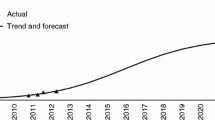Summary
Retailers have been criticized for heavily relying on odd prices although their advantage over even prices has not been convincingly proven. In this paper we argue that such behavior does not have to stern solely from tradition, but may be seen as a rational way of dealing with uncertainty.
We review 22 empirical studies on the effects of odd versus even prices and find that the results are inconclusive as to whether threshold effects exist. In an analysis of profit contributions we then show that in the light of such uncertainty it is rational to set odd prices. The reason is that only small losses in profit contribution are incurred when odd prices are set although no thresholds exist. In the opposite case, however, losses can be quite substantial. Results of a response surface analysis show the size of the two errors for a wide range of response parameters.
Similar content being viewed by others
Literatur
Bader, L./ Weinland, J. D. (1932), Do Odd Prices Earn Money?, in: Journal of Retailing, Vol. 8, S. 102–104.
Blattberg, R. C./ Neslin, S. A. (1990), Sales Promotion: Concepts, Methods, and Strategies.
Blattberg, R. C/ Wisniewski, K.J. (1987), How Retail Price Promotions Work: Empirical Results, in: Marketing Working Paper No. 42, Graduate School of Business, University of Chicago, zitiert nach.
Blattberg, R. C./ Neslin, S. A. (1990), Sales Promotion: Concepts, Methods, and Strategies, S. 367 ff.
Box, G. E. P./ Hunter, W. G./ Hunter, J. S. (1978), Statistics for Experimenters.
Bultez, A. V/ Naert, P. (1979), Does Lag Structure Really Matter in Optimizing Advertising Expenditures?, in: Management Science, Vol. 25, S. 454–465.
Bultez, A. V./ Naert, P. (1988), When Does Lag Structure Really Matter... Indeed?, in: Management Science, Vol. 34, S. 909–916.
Chintagunta, P. K. (1993), Investigating the Sensitivity of Equilibrium Profits to Advertising Dynamics and Competitive Effects, in: Management Science, Vol. 39, S. 1146–1162.
Dahlhäuser, H. (1996), Prominenz der Preise in einem Warenhauskatalog, in: ZfbF, 48. Jg., S. 711–737.
Dalrymple, D.J./ Haines, G. H. Jr. (1970), A Study of the Predictive Ability of Market Period Demand-Supply Relations for a Firm Selling Fashion Products, in: Applied Economics, Vol. 1, S. 277–285.
Dean, J. (1951), Managerical Economics.
Diller, H./ Brielmaier, A. (1996), Die Wirkungen gebrochener und runder Preise. Ergebnisse eines Feldexperiments im Drogeriewarensektor, in: ZfbF, 48. Jg., S. 695–710.
Dodds, W. B./ Monroe, K. B. (1985), The Effect of Brand and Price Information on Subjective Product Evaluations, in: Advances in Consumer Research, Vol. 12, S. 85–90.
Fielitz, H. (1958), Den Preis nicht unterschätzen!, in: Neue Betriebswirtschaft, 11. Jg., Heft 7, S. 132–134.
Gabor, A./ Granger, C. W.J. (1964), Price Sensitivity of the Consumer, in: Journal of Advertising Research, Vol. 4 (4), S. 40–44.
Gabor, A./ Granger, C. W.J. (1966), Price as an Indicator of Quality: Report on an Enquiry, in: Economica, Vol. 33, S. 43–70.
Georgoff, D. M. (1972), Odd-Even Retail Price Endings.
Ginzberg, E. (1936), Customary Prices, in: American Economic Review, Vol. 26, S. 296.
Kaas, K. P./ Hay, C. (1984), Preisschwellen bei Konsumgütern - eine theoretische und empirische Analyse, in: ZfbF, 36. Jg., S. 333–346.
Kucher, E. (1985), Scannerdaten und Preissensitivität bei Konsumgütern.
Lambert, Z. V. (1975), Perceived Price as Related to Odd and Even Price Endings, in: Journal of Retailing, Vol. 51, S. 13–22, 78.
Magat, W. A./ McCann, J. M./ Morey, R. C. (1986), When Does Lag Structure Really Matter in Optimizing Advertising Expenditures?, in: Management Science, Vol. 32, S. 182–193.
Magat, W. A./ McCann, J. M./ Morey, R. C. (1988), Reply to “When Does Lag Structure Really Matter... Indeed?”, in: Management Science, Vol. 34, S. 917–918.
Müller, S./ Bruns, H. (1984), Der Einfluvon Glattpreisen auf Kaufentscheidungen, in: Marketing Zeitschrift für Forschung und Praxis, 6. Jg., S. 175–180.
Müller, S./ Hoenig, J. (1983), Die Preisbeachtung in einer realen Kaufsituation, in: Jahrbuch der Absatz-und Verbrauchsforschung, 5. Jg., S. 321–43.
Müller, S./ Brücken, M./ Heuer-Potthast, I. (1982), Die Wirkung gebrochener Preise bei Entscheidungen mit geringem und hohem Risiko, in: Jahrbuch der Absatz- und Verbrauchsforschung, 4. Jg., S. 360–385.
Schindler, R. M. (1984), Consumer Recognition of Increases in Odd and Even Prices, in: Advances in Consumer Research, Vol. 11, S. 459–462.
Schindler, R. M./ Wiman, A. R. (1989), Effects of Odd Pricing on Price Recall, in: Journal of Business Research, Vol. 19, S. 165–177.
Schindler, R. M/ Warren, L. S. (1988), Effect of Odd Pricing on Choice of Items From A Menu, in: Advances in Consumer Research, Vol. 15, S. 348–353.
Schindler, R. M/ Kibarian, T. M. (1996), Increased Consumer Sales Response Through Use of 99-Ending Prices, in: Journal of Retailing, Vol. 72, S. 187–199
Schindler, R. M J Kirby, P. N. (1997), Patterns of Rigthmost Digits Used in Advertised Prices: Implications for Nine-Ending Effects, in: Journal of Consumer Research, Vol. 24, S. 192–201.
Silver, MJ Tull, D. S. (1986), Pricing and the Flat-Maximum Principle, in: Managerial & Decision Economics, Vol. 7, S. 203–206.
Simon, H. (1992), Preismanagement, Analyse-Strategie-Umsetzung, 2. Aufl.
Skiera, B. (1997), Das Prinzip des flachen Maximums, in: Die Betriebswirtschaft, 57. Jg., S. 864–867.
Stiving, M./ Winer, R. S. (1997), An Empirical Analysis of Price Endings Using Scanner Data, in: Journal of Consumer Research, Vol. 23, S. 57–67.
Tellis, G.J. (1988), The Price Elasticity of Selective Demand: A Meta-Analysis of Econometric Models of Sales, in: Journal of Marketing Research, Vol. 25, S. 331–341.
Tuli, D. S. et al. (1986), “Leveraged” Decision Making in Advertising: The Fiat Maximum Principle and Its Implications, in: Journal of Marketing Research, Voi. 23, S. 25–32.
Wasson, C. R. (1965), The Psychological Aspects of Price, in: C. R. Wasson (Hrsg.): The Economics of Managerial Decision: Profit Opportunity Analysis, S. 130–133.
Author information
Authors and Affiliations
Rights and permissions
About this article
Cite this article
Gedenk, K., Sattler, H. Preisschwellen und Deckungsbeitrag — Verschenkt der Handel gro Potentiale?. Schmalenbachs Z betriebswirtsch Forsch 51, 33–59 (1999). https://doi.org/10.1007/BF03371558
Published:
Issue Date:
DOI: https://doi.org/10.1007/BF03371558




